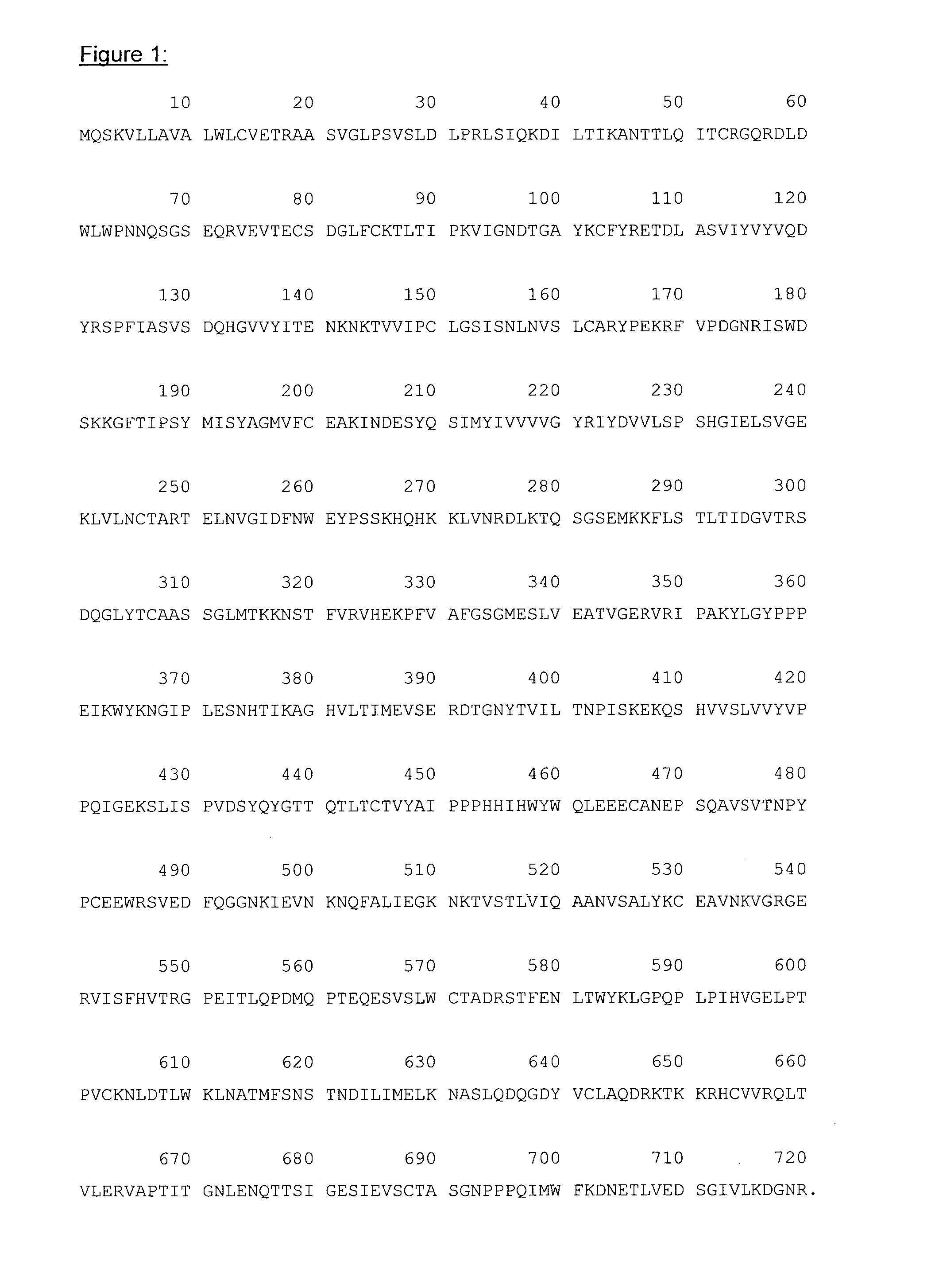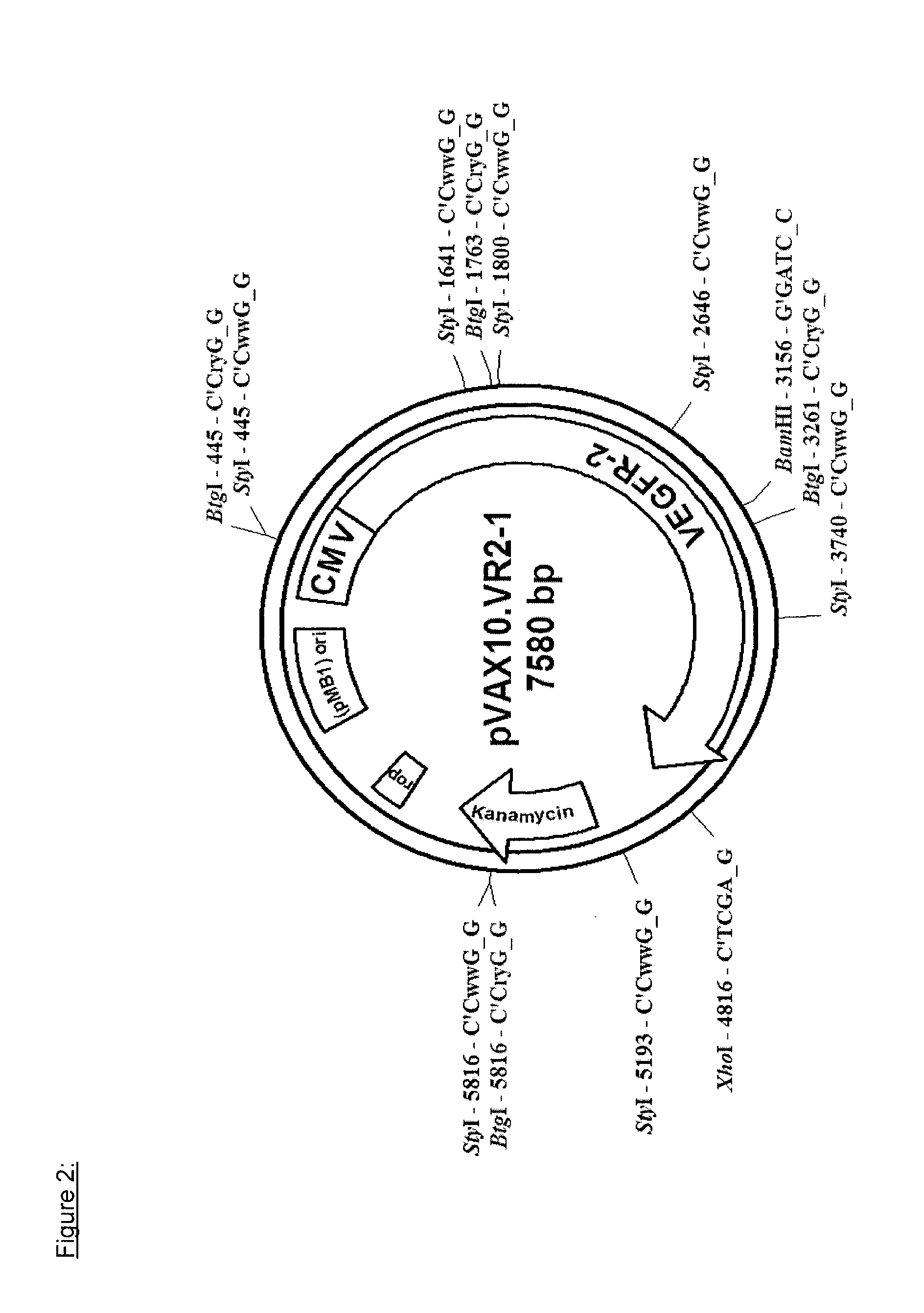DNA vaccine for use in pancreatic cancer patients
a pancreatic cancer and rna technology, applied in the field of attenuated mutant strains of salmonella, can solve the problems of tumor encapsulation, loss or down-regulation of mhc molecules, and cancer patients' selection of non-antigen bearing cells, and achieve the effect of improving the treatment options
- Summary
- Abstract
- Description
- Claims
- Application Information
AI Technical Summary
Benefits of technology
Problems solved by technology
Method used
Image
Examples
example 1
Salmonella typhi Ty21a Strain Preparation and Plasmid Preparation
[0121]The first step in the preparation of the research seed lot (RSL) consisted of the isolation of the attenuated Salmonella typhi Ty21a strain followed by the transformation of the attenuated bacteria with the plasmid DNA (pVAX10.VR2-1).
[0122]Liquid culture medium was inoculated with a Salmonella typhi Ty21a isolate and the liquid culture was then plated onto an agar medium for the purpose of isolating single bacterial colonies. Single colonies were isolated and grown in liquid culture medium. Two cultures, namely VAX.Ty21-1 and VAX.Ty21-2, were then formulated with glycerol, aliquoted (1 ml) and stored at −75° C.±5° C. pending use. Identity of each of the two cultures was further confirmed.
[0123]The principle of plasmid synthesis was based on double strand in vitro gene synthesis with the following steps:[0124]The whole pVAX10-VR2.1 plasmid sequence of 7.58 kb was subdivided (by software analysis) in 5 sections of ...
example 2
VXM01—Phase I Clinical Trial; Study Description
[0135]This phase I trial examined the safety, tolerability, and immunological and clinical responses to VXM01. The randomized, placebo-controlled, double blind dose-escalation study included 45 patients with locally advanced or stage IV pancreatic cancer. The patients received four doses of VXM01 or placebo in addition to gemcitabine as standard of care. Doses from 106 CFU up to 1010 CFU of VXM01 were evaluated in the study. An independent data safety monitoring board (DSMB) was involved in the dose-escalation decisions. In addition to safety as primary endpoint, the VXM01-specific immune reaction, as well as clinical response parameters were evaluated.
Preclinical Efficacy Assessment:
[0136]The efficacy and safety of this approach in animals has been validated multiple times by the inventors. Further experiments by the inventors showed an activity of this vaccine in two different models of pancreatic cancer.
[0137]VXM01, the vaccine used ...
example 3
VXM01 Specific T-Cell Responses
[0158]Responses to VXM01 were assessed by monitoring the frequencies of VEGFR2 specific T-cells in peripheral blood of VXM01 and placebo treated patients, detected by INFγ ELISpot, at different time points prior during and post vaccination.
[0159]Firstly, T-cells and peptide pulsed DC were added to wells coated with anti-INFγ antibodies. After a period of incubation, cells were removed with secreted INFγ left binding with the coat antibodies. Then detection antibody was added to detect the bound INFγ, and after a signal amplification, the final yield could be viewed as “color spots” representing single activated and specific T-cells.
[0160]Positivity of ELISpot samples was graded according to predefined rules defining signal increase resulting in grade 0 to 3 per sample:
No increase: grade 0
Clear increase but<3×: grade 1
≧3×but<5× increase: grade 2
≧5× increase: grade 3
[0161]The ELISpot immune response of study patients is depicted in Table 2:
TABLE 2VEGFR-2...
PUM
| Property | Measurement | Unit |
|---|---|---|
| Fraction | aaaaa | aaaaa |
| Electrical resistance | aaaaa | aaaaa |
| Chemotherapeutic properties | aaaaa | aaaaa |
Abstract
Description
Claims
Application Information
 Login to View More
Login to View More - R&D
- Intellectual Property
- Life Sciences
- Materials
- Tech Scout
- Unparalleled Data Quality
- Higher Quality Content
- 60% Fewer Hallucinations
Browse by: Latest US Patents, China's latest patents, Technical Efficacy Thesaurus, Application Domain, Technology Topic, Popular Technical Reports.
© 2025 PatSnap. All rights reserved.Legal|Privacy policy|Modern Slavery Act Transparency Statement|Sitemap|About US| Contact US: help@patsnap.com



